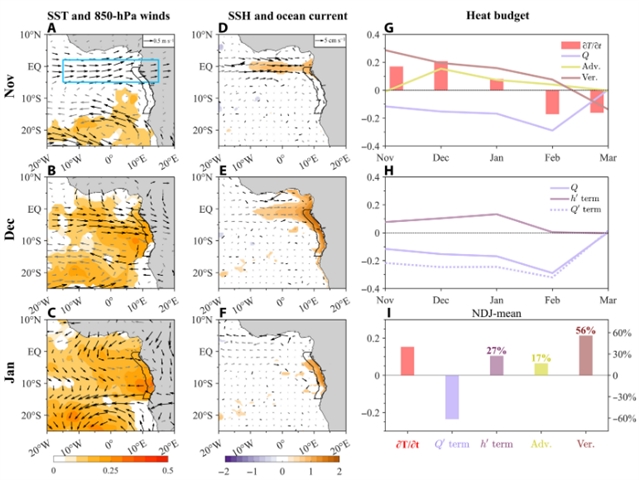
近日,中国科学院南海海洋研究所张磊团队报道了
热带东南大西洋(TSEA)沿岸的海洋热浪对海洋生态系统和生产力造成了毁灭性的影响。
通过观测分析和数值模式试验,研究组发现印度洋正偶极子(pIOD)通过两个不同的过程增强了夏季TSEA沿岸强热带气旋。首先,pIOD引起赤道大西洋上空的西风异常,通过海洋开尔文波引导TSEA沿岸温跃层加深,有利于强震的发展。其次,pIOD增强了中非降水,增加了刚果河流量,导致TSEA沿海地区混合层变浅,也促进了MHW的形成。
研究组进一步开发了一个实证模型,采用pIOD作为TSEA MHWs的预测因子,在3个月的预估时间内显示出较高的预测能力。在气候变暖的情况下,pIOD对TSEA MHWs的远程影响可能会进一步加剧,因此迫切需要将这一因素纳入该区域的海洋灾害预报。
附:英文原文
Title: Positive Indian Ocean Dipole intensifies marine heatwaves in the tropical southeast Atlantic coastal region
Author: Heng Liu, Lei Zhang, Michael J. McPhaden, Weiqing Han, Haiyu Li
Issue&Volume: 2025-10-17
Abstract: Marine heatwaves (MHWs) along the tropical southeast Atlantic (TSEA) coast have devastating impacts on marine ecosystems and productivity. Through observational analysis and numerical model experiments, we demonstrate that positive Indian Ocean Dipole (pIOD) can intensify TSEA coastal MHWs during austral summer through two distinct processes. First, pIOD induces westerly wind anomalies over the equatorial Atlantic, causing thermocline deepening along the TSEA coast through oceanic Kelvin waves, favoring development of MHWs. Second, pIOD enhances rainfall over central Africa, increasing Congo River discharge and resulting in a shallower mixed layer in the TSEA coastal region, also promoting MHW formation. We further develop an empirical model using pIOD as the predictor for TSEA MHWs, demonstrating high predictive skill with a 3-month lead time. In a warming climate, the remote influence of pIOD on TSEA MHWs may be further exacerbated, underscoring critical need to incorporate this factor into marine hazard forecasting for the region.
DOI: adx8525
Source: https://www.science.org/doi/10.1126/sciadv.adx8525
